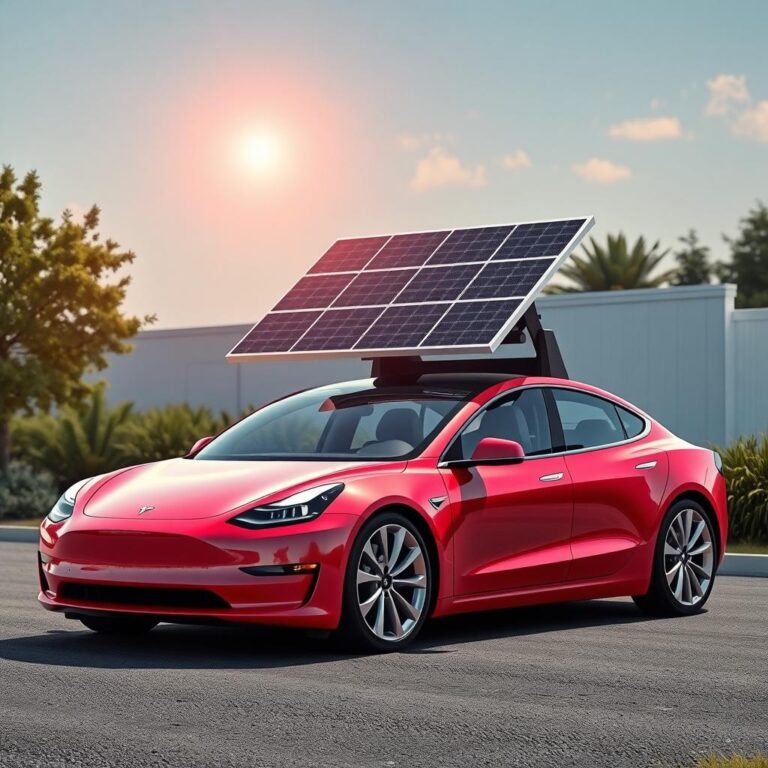Are Tesla Cars Better For The Environment?
Are Tesla cars better for the environment? This is a question that many people ask when considering switching to an electric vehicle (EV). Tesla, as a leader in the electric vehicle market, is often touted as a major player in reducing carbon emissions and promoting sustainable transportation. But are Tesla cars truly better for the environment, or is it just a marketing strategy? Let’s explore the environmental impact of Tesla cars and how they compare to traditional gas-powered vehicles.
How Tesla Cars Help the Environment
Tesla cars are electric vehicles, which means they don’t rely on gasoline or diesel to power their engines. Instead, they are powered by electricity stored in large batteries, which provides several environmental benefits. Here are some of the most significant ways Tesla cars help reduce their environmental impact:
- Zero Emissions: One of the most obvious environmental benefits of Tesla cars is that they produce zero tailpipe emissions. Unlike gas-powered vehicles, Teslas don’t release harmful pollutants like carbon dioxide (CO2), nitrogen oxides (NOx), or particulate matter. This significantly reduces air pollution, especially in urban areas where traffic congestion leads to higher emissions.
- Reduction in Greenhouse Gases: The burning of fossil fuels for transportation is a major contributor to greenhouse gas emissions, which cause global warming. By driving a Tesla, you’re helping reduce the demand for gasoline and diesel, thus lowering the overall greenhouse gas emissions from the transportation sector.
- Improved Energy Efficiency: Electric vehicles like Tesla are more energy-efficient than traditional vehicles. Electric motors are much more efficient than internal combustion engines at converting energy into movement. This means that Tesla cars require less energy to travel the same distance, which reduces the amount of energy needed for transportation.
- Support for Renewable Energy: Tesla is also working to integrate renewable energy sources with its electric vehicle technology. Tesla’s solar panels and energy storage systems, like the Powerwall, can help homeowners generate and store clean energy, which can then be used to charge their Tesla cars. By using renewable energy sources to power a Tesla, the environmental impact becomes even lower.
Life Cycle Analysis: Are Tesla Cars Truly Green?
While Tesla cars are definitely more environmentally friendly than traditional vehicles, it’s important to consider the full life cycle of the car to understand its total environmental impact. This includes everything from manufacturing to disposal. Let’s break down the different phases of a Tesla’s life cycle and see how they compare to traditional vehicles:
1. Manufacturing and Raw Materials
Manufacturing an electric vehicle (EV) like a Tesla requires raw materials like lithium, cobalt, nickel, and other metals for the batteries. The mining and processing of these materials can have significant environmental impacts, including habitat destruction, water contamination, and carbon emissions from the mining processes. For example, lithium extraction in areas like Chile’s salt flats can lead to water shortages in local communities.
However, it’s worth noting that Tesla has made significant strides to improve the sustainability of its manufacturing processes. The company aims to reduce the environmental impact of battery production through efforts like recycling old batteries and sourcing materials more responsibly. Tesla is also developing new battery technologies that could use less harmful materials and be more energy-efficient to manufacture.
2. Battery Production and Disposal
Battery production is one of the most energy-intensive parts of manufacturing an electric vehicle. The production of lithium-ion batteries used in Tesla cars generates a considerable amount of CO2 emissions. However, once the car is on the road, the emissions from driving are much lower than those of a traditional gas-powered car, so the initial carbon footprint of battery production is offset over time.
Another issue is the disposal of used batteries. While Tesla is working on improving battery recycling technologies, the disposal of EV batteries can still be problematic if not handled properly. When batteries are not recycled, they can contribute to environmental pollution, as the metals and chemicals inside the batteries can leach into the ground. Tesla’s commitment to battery recycling and developing a circular economy for its battery materials is helping to address this issue.
3. Charging the Tesla
Another factor that determines how green Tesla cars are is the source of the electricity used to charge them. If you charge your Tesla using electricity generated from coal or other fossil fuels, the environmental benefits of driving an electric vehicle are reduced. However, if you use renewable energy sources like solar or wind power to charge your Tesla, the overall environmental impact is significantly lower.
Tesla encourages its customers to use renewable energy whenever possible, and the company’s solar products and energy storage solutions can help make this a reality. Charging your Tesla using clean, renewable energy can effectively eliminate the carbon emissions associated with driving the vehicle, making it a truly sustainable option.
4. Vehicle Longevity and Recycling
One of the benefits of Tesla cars is that they are built to last. Tesla vehicles are known for their longevity, with many owners reporting that their cars continue to perform well even after hundreds of thousands of miles. A longer vehicle lifespan means that the environmental impact of manufacturing and disposal is spread out over a longer period, which reduces the overall environmental footprint.
Furthermore, Tesla has implemented various initiatives to recycle materials and parts from old cars. The company aims to create a closed-loop system for vehicle production, where old cars are broken down and their parts are reused in the production of new vehicles. This reduces the need for new raw materials and lowers the environmental impact of manufacturing.
The Overall Environmental Impact of Tesla Cars
So, are Tesla cars better for the environment? The answer is generally yes, especially when compared to traditional gas-powered vehicles. Tesla cars produce zero emissions while driving, which significantly reduces air pollution and greenhouse gas emissions. They are also more energy-efficient, require less maintenance, and offer the potential for charging with renewable energy sources.
However, the environmental impact of Tesla cars is not entirely zero. The manufacturing process, particularly the production of batteries, has a significant environmental footprint. Additionally, the source of the electricity used to charge a Tesla plays a crucial role in determining how green the vehicle is. By using clean, renewable energy to power your Tesla, you can maximize the environmental benefits of owning an electric car.
In conclusion, while there are challenges associated with the production and disposal of Tesla cars, they are still far better for the environment than traditional internal combustion engine vehicles. Tesla continues to innovate and improve its manufacturing processes, and with the potential for widespread adoption of renewable energy sources, electric vehicles like Teslas are an essential part of a more sustainable future.

Electric Cars vs. Gas-Powered Cars: A Direct Comparison
To better understand why Tesla cars are better for the environment, let’s directly compare electric vehicles like Tesla with traditional gas-powered cars. A few key factors will help you see the clear environmental advantage of EVs:
1. Emissions
The most obvious environmental benefit of Tesla cars over gas-powered vehicles is emissions. Traditional vehicles release harmful pollutants, including carbon dioxide (CO2), nitrogen oxides (NOx), and particulate matter, which contribute to climate change and air pollution. These emissions are particularly harmful in cities with heavy traffic, where pollution levels can soar.
On the other hand, Tesla cars produce zero tailpipe emissions. As a result, driving a Tesla helps eliminate a significant portion of the pollution caused by conventional vehicles. This is especially important for urban areas where air quality is a growing concern, as Teslas help improve the air quality and reduce the overall carbon footprint of transportation.
2. Carbon Footprint Over Time
Although the production of a Tesla—specifically the batteries—can generate more carbon emissions than building a traditional car, this difference is quickly outweighed once the vehicle is on the road. Tesla cars are more energy-efficient and have lower lifetime emissions compared to internal combustion engine (ICE) vehicles. Over time, as you drive the car and reduce your reliance on fossil fuels, the carbon footprint of the Tesla becomes much lower than that of a conventional gas-powered vehicle.
Research shows that even with the energy-intensive process of battery manufacturing, electric vehicles (EVs) can lower overall CO2 emissions within a few years of use, depending on the source of electricity. For instance, if you charge your Tesla using renewable energy sources like wind or solar power, the emissions associated with driving the vehicle could be negligible.
3. The Efficiency of Electric Motors
Another environmental benefit of Tesla cars lies in their efficiency. Electric motors are far more efficient than internal combustion engines at converting energy into motion. While an internal combustion engine may only use 20-30% of the energy in the fuel to power the wheels, an electric motor can use over 85-90% of the energy from the battery for movement.
Higher efficiency means that Tesla cars use less energy to travel the same distance, which in turn reduces the overall demand for electricity and the carbon footprint associated with driving. If your Tesla is powered by a grid that is increasingly sourced from renewable energy, this efficiency improves even further, leading to a substantial reduction in environmental impact.
Does Tesla Help Promote the Use of Renewable Energy?
One of the most significant ways Tesla contributes to sustainability is by encouraging the use of renewable energy. Tesla’s mission goes beyond just producing electric cars; the company is working to transition the world to sustainable energy. Tesla’s clean energy products, such as solar panels, Solar Roof, and energy storage solutions like the Powerwall, play a critical role in this transition.
If Tesla owners use solar energy to power their homes and charge their electric cars, the environmental benefits are compounded. For example, using a Tesla Solar Roof or solar panels to generate clean electricity can completely eliminate the carbon emissions from charging a Tesla vehicle. This aligns with Tesla’s broader goal of reducing humanity’s reliance on fossil fuels and making renewable energy more accessible to everyone.
The Future of Tesla and Sustainability
As Tesla continues to innovate, the company is making significant strides in sustainability, not only in its cars but in its entire business model. Tesla is working on making the battery production process more sustainable, exploring the use of more environmentally-friendly materials, and improving battery recycling methods. Additionally, the company is focused on making its entire manufacturing process more energy-efficient and less resource-intensive.
Looking ahead, Tesla plans to ramp up its production of electric vehicles, with plans to manufacture more affordable models, increasing access to clean transportation. In the future, as more countries transition to renewable energy grids, the environmental impact of Tesla cars will continue to decrease. Furthermore, Tesla’s innovations in energy storage and solar technology could play a crucial role in driving the world toward a sustainable future.
Challenges and Areas for Improvement
While Tesla is a leader in sustainable transportation, there are still challenges that need to be addressed. Some of these challenges include:
- Battery Manufacturing and Raw Materials: As mentioned earlier, the process of extracting raw materials for electric vehicle batteries can have significant environmental impacts, such as habitat destruction, water usage, and carbon emissions. Tesla and other manufacturers are working on reducing these impacts by sourcing materials responsibly and investing in battery recycling technologies.
- Energy Grid Dependence: The environmental benefits of Tesla cars are partly dependent on the energy mix of the local grid. If you live in an area where electricity is primarily generated from coal or other non-renewable sources, the carbon footprint of driving a Tesla can still be significant. However, as more regions shift to renewable energy sources, this issue will become less of a concern.
- Battery Disposal: While Tesla is focused on improving battery recycling, there is still room for improvement in the long-term management of battery disposal. As more EVs hit the road, finding sustainable ways to recycle and reuse EV batteries will be critical to reducing the overall environmental impact of electric vehicles.
Conclusion: Are Tesla Cars Better for the Environment?
In conclusion, yes—Tesla cars are better for the environment compared to traditional gas-powered vehicles. By producing zero emissions, offering higher energy efficiency, and promoting the use of renewable energy, Tesla cars are leading the way in the transition to sustainable transportation. While there are still challenges to overcome, such as the environmental impact of battery production and disposal, Tesla’s commitment to sustainability, combined with its innovations in clean energy, makes its vehicles an excellent choice for those looking to reduce their environmental impact.
As technology improves and more regions adopt renewable energy sources, the environmental benefits of driving a Tesla will continue to increase, contributing to a cleaner and more sustainable future for all.


